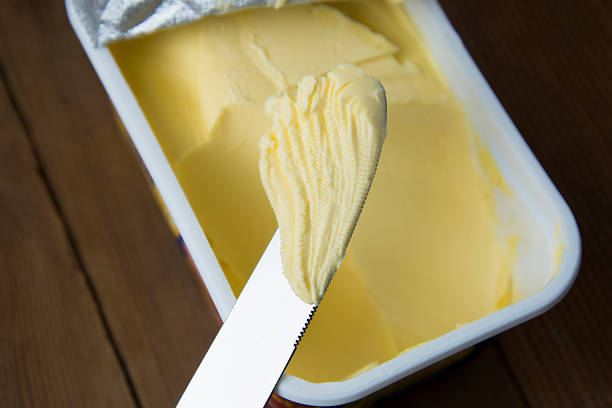The rather glib comment of Mark Twain’s businessman recorded in Life on the Mississippi (1883) that “butter don’t stand any show – there ain’t any chance for competition” was rather wide of the mark, seriously underestimating the ferocious reaction to the interloper from the dairy industry. After all, butter had been a staple of the human diet for over four millennia with nary a challenger.
Impassioned speeches were made in favour of “sweet and wholesome butter” while its new competitor was characterized as the result of “the ingenuity of depraved human genius”. Cartoonists showed manufacturers dropping all manner of substances ranging from cats to rubber boots, even soap, paint, and arsenic, into the margarine mix while quasi-scientific reports were published suggesting that it was cancerous and its consumption possibly led to insanity.
The American dairy industry’s smear campaign began to bear fruit with margarine initially declared a “harmful drug” and its sale restricted, and then the passing of the Margarine Act in 1886, the first of a series, which imposed restrictive tariffs and fees on producers. Some states even banned its sale, leading to the emergence of a profitable black market. It was not until 1950 that federal taxes on margarine were abolished.
A surprising but fiercely fought over battleground in the dispute between butter and margarine producers was the question of colour. Butter derives its familiar yellow colour from the antioxidant vitamin beta-carotene found in the grass grazed by cattle. Margarine, however, in its original manufactured state, has a whiteish colour, not unlike lard. In an effort to improve the appearance of their product and to emphasise that it was a butter substitute, manufacturers began to colour margarine yellow.
Butter producers claimed that this practice was a deliberate attempt to deceive consumers. By 1902 the Federal government had imposed a tax on coloured margarine of 10 cents per pound, forty times higher than that on white margarine, and 32 states had passed legislation imposing constraints on its sale. In response margarine manufacturers distributed margarine in its natural state together with a sachet of yellow dye which the consumer, in a process known as “butter stomping”, added and mixed into the margarine in the comfort of their own home.
In an age before food mixers, it was a time-consuming process with variable results, a task often delegated to children. There was even a special implement, a stomper, that could be bought but most households used a spatula, a wooden spoon, or, if mother was not looking, fingers. It was not until 1967 that the last state, Wisconsin, repealed its legislation around the colour of margarine, while restrictions persisted in Quebec until the early 2000s.
Vermont, New Hampshire, and South Dakota went even further by demanding that margarine be dyed pink. Sellers of non-pink margarine could face a fine of $100 or sixty days in prison. Margarine manufacturers fought back, the Supreme Court finding in their favour in 1898 by ruling that “pink is not the colour of oleomargarine in its natural state” and that rendering it that colour “excites a prejudice and strengthens a repugnance up to the point of a positive and absolute refusal to purchase the article at any price”.
Nowadays most margarine is indistinguishable in colour from butter, but suspicions still linger that it is the poorer substitute. Foreshadowing the scone stushie, in 2017 Jan Polanik sued twenty-three Dunkin’ Donuts outlets in central and eastern Massachusetts for serving him “margarine or a butter substitute” instead of butter with his bagels. The court found in his favour, although his greedy lawyer took an enormous bite out of his $95,000 damages.
The butter margarine debate is certain to rumble on for some time. At least, if you choose to spread margarine on your toast, it is not pink.

